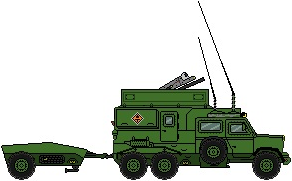CTC Pelican Drone Terra-carrier
| Pelican Drone Terra-carrier | |
|---|---|
 In its closed and open, ready to launch positions, the latter with the additional battery in tow. | |
| Type | Armored UAV carrier |
| Place of origin | |
| Service history | |
| In service | 2027-present |
| Used by | |
| Production history | |
| Designer | CTC |
| Unit cost | €1.5 million |
| Produced | 2025 - present |
| No. built | 37 built, 84 under construction or planned |
| Specifications | |
| Length | 6 m (19 ft 8 in) |
| Width | 2.5 m (8 ft 2 in) |
| Height | 2.8 m (9 ft 2 in) |
| Crew | 4 ((driver, communications/network officer (C/NO), mechanic, and assistant mechanic/ordnance technician (AM/OT])) |
| Armour | Composite with mounting studs for additional plates
|
Secondary armament | 4 medium sized drones |
| Engine | Diesel-electric hybrid powertrain |
| Suspension | 6-wheel drive |
Operational range | 600 km (370 mi) |
| Maximum speed |
|
The CTC Pelican is the first-of-its-kind drone transportation, maintenance, and launch vehicle. Developed as a joint project between Cross Trucking Company (CTC) and Hered Defense Systems (HDS), the Pelican is a 6x6 armored vehicle designed from the ground up to transport, maintain, and launch drones in the field. From the outside, it looks similar to an APC or a self-propelled mortar. It was researched and designed on a contract for the Army of Burgundie from 2012-2023 and went into production in 2025 and was adopted by the Army of Burgundie in 2027. CTC subcontracted HDS in 2015 for the design and integration of the drone launch and recovery system, as well as the advanced communication and connectivity features that enable seamless operation of the drones.
Operational use
The top of the vehicle opens in the same way that a self-propelled mortar does, so drones can be launched from within the vehicle under fire. However, the typical MO is to park the vehicle out of harm's way and fly numerous drones from outside the vehicle.
Burgundie
The variant used in Burgundie Pelican Drone Terra-carrier is unique in that it does not typically operate the drones it carries itself. The carrier is designed for teams that operate with the same relationship to forward combat units as does artillery support. The Pelican moves into the area of operations, the crew dismounts and the communications/network officer works with the requesting unit(s) to determine drone type, capability/payload needed. Once the mission parameters are set, the C/NO relays the requirements to the AM/OT to fit the recommended drone platform with the requisite instruments/payload. The mechanic then launches the drone, and the C/NO patches control to the requesting unit's drone operators. This allows a Pelican crew to bring 4 large body tactical combat/surveillance drones into an AO and dispatch them almost simultaneously to a variety of units regardless of command structure.
It currently serves at the battalion and brigade level as an independent platoon-level asset, a platoon being three Pelicans, their crew, and supply elements.
Specifications

Vehicle Type: Armored Unmanned Aerial Vehicle Carrier (AUAVC)
Dimensions:
Length: Approximately 6 meters
Width: Approximately 2.5 meters
Height: Approximately 2.8 meters
Crew Capacity: 4 (driver, communications/network officer (C/NO), mechanic, and assistant mechanic/ordnance technician (AM/OT])
Armor Protection: Ballistic and blast-resistant armor to protect against small arms fire and shrapnel Modular armor for customization based on mission requirements
Engine: Diesel-electric hybrid powertrain High-torque diesel engine combined with an electric motor
Battery There is a commercial electric car battery built into the chassis to charge the drones between missions with rapid charging capabilities. It is recharged by the diesel-electric engine in generator mode. For missions with high endurance requirements, a extra battery trailer can be towed along.
Armament: N/A
Mobility: 6x6 wheel configuration for off-road capability High-performance suspension for rough terrain All-wheel drive and amphibious capability
Speed: On-road speed: Approximately 90 km/h (56 mph) Off-road speed: Approximately 45 km/h (28 mph)
Range: Extended range due to the hybrid system, approximately 600 kilometers (370 miles) on a single tank of fuel
UAV Launch and Recovery System: Integrated launch and recovery system for medium-sized UAVs Launching platform and recovery net or landing pad Remote operation capabilities for the UAV operator
Communication and Connectivity: Advanced communication systems for secure data links with deployed UAVs Satellite communication for long-range connectivity
Sensors and Surveillance: Integrated sensor suite including cameras, radar, and electronic warfare systems UAV control station with multiple screens and data feeds
Cargo Capacity: Space for multiple medium-sized UAVs, spare parts, explosive payloads, and equipment
Survivability: Smoke grenade launchers NBC (Nuclear, Biological, Chemical) protection system
Operational Use: Primarily used for reconnaissance and surveillance missions Rapid deployment and retrieval of medium-sized UAVs in the battlefield Support for real-time data collection and analysis